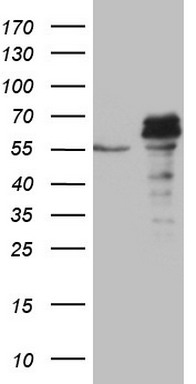SUOX Mouse Monoclonal Antibody (Biotin conjugated) [Clone ID: OTI5A2]
CAT#: TA805951AM
SUOX mouse monoclonal antibody, clone OTI5A2 (formerly 5A2), Biotinylated
Other products for "SUOX"
Specifications
| Product Data | |
| Clone Name | OTI5A2 |
| Applications | IHC, WB |
| Recommended Dilution | WB 1:500, IHC 1:150 |
| Reactivities | Human, Mouse, Rat |
| Host | Mouse |
| Isotype | IgG2b |
| Clonality | Monoclonal |
| Immunogen | Human recombinant protein fragment corresponding to amino acids 320-545 of human SUOX(NP_000447) produced in E.coli. |
| Formulation | PBS (PH 7.3) containing 1% BSA, 50% glycerol and 0.02% sodium azide. |
| Concentration | 0.5 mg/ml |
| Purification | Purified from mouse ascites fluids or tissue culture supernatant by affinity chromatography (protein A/G) |
| Conjugation | Biotin |
| Storage | Store at -20°C as received. |
| Stability | Stable for 12 months from date of receipt. |
| Predicted Protein Size | 60.1 kDa |
| Gene Name | sulfite oxidase |
| Database Link | |
| Background | Sulfite oxidase is a homodimeric protein localized to the intermembrane space of mitochondria. Each subunit contains a heme domain and a molybdopterin-binding domain. The enzyme catalyzes the oxidation of sulfite to sulfate, the final reaction in the oxidative degradation of the sulfur amino acids cysteine and methionine. Sulfite oxidase deficiency results in neurological abnormalities which are often fatal at an early age. Alternative splicing results in multiple transcript variants encoding identical proteins. [provided by RefSeq, Jul 2008] |
| Synonyms | OTTHUMP00000158619; sulfite oxidase |
| Reference Data | |
| Protein Families | Druggable Genome |
| Protein Pathways | Sulfur metabolism |
Documents
| Product Manuals |
| FAQs |
| SDS |
{0} Product Review(s)
0 Product Review(s)
Submit review
Be the first one to submit a review
Product Citations
*Delivery time may vary from web posted schedule. Occasional delays may occur due to unforeseen
complexities in the preparation of your product. International customers may expect an additional 1-2 weeks
in shipping.






























































































































































































































































 Germany
Germany
 Japan
Japan
 United Kingdom
United Kingdom
 China
China






